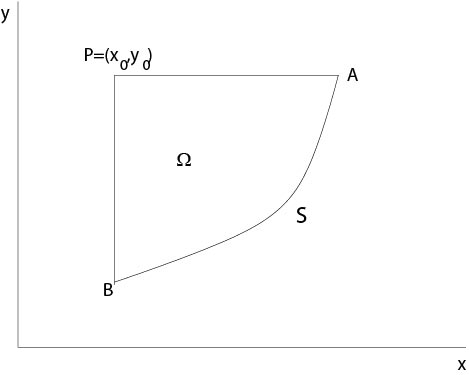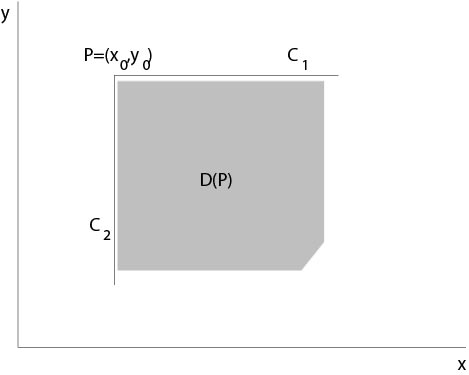4.4: A Method of Riemann
( \newcommand{\kernel}{\mathrm{null}\,}\)
Riemann's method provides a formula for the solution of the following Cauchy initial value problem for a hyperbolic equation of second order in two variables. Let
$${\mathcal S}:\ \ x=x(t), y=y(t),\ \ t_1\le t \le t_2,\]
be a regular curve in
$$Lu:=u_{xy}+a(x,y)u_x+b(x,y)u_y+c(x,y)u,\]
where
where
We assume:
We recall that the characteristic equation to (
Assume
$$Mv=v_{xy}-(av)_x-(bv)_y+cv.\]
We have
Set
From (
where integration in the line integral is anticlockwise. The previous equation follows from Gauss theorem or after integration by parts:
$$\int_\Omega\ (-P_y+Q_x)\ dxdy=\int_{\partial\Omega}\ (-Pn_2+Qn_1)\ ds,\]
where
Assume
$$Mv=0\ \ \mbox{in}\ \Omega.\]

Figure 4.4.1: Riemann's method, domain of integration
Then, if we integrate over a domain
The line integral from
Since
$$u_xv-v_xu+2buv=(uv)_x+2u(bv-v_x),\]
it follows
By the same reasoning we obtain for the third line integral
Combining these equations with (
Let

Figure 4.4.2: Definition of Riemann's function
Assume
where the right hand side is known from given data.
A function
Remark. Set
Example 4.4.1:
Example 4.4.2:
Consider the telegraph equation of Chapter 3
$$\varepsilon \mu u_{tt}=c^2\triangle_xu-\lambda\mu u_t,\]
where
Introducing
$$u=w(x,t)e^{\kappa t},\]
where
$$w_{tt}=\frac{c^2}{\varepsilon\mu}\triangle_xw-\frac{\lambda^2}{4\epsilon^2}.\]
Stretching the axis and transform the equation to the normal form we get finally the following equation, the new function is denoted by
$$u_{xy}+cu=0,\]
with a positive constant
$$v(x,y;x_0,y_0)=w(s),\ \ s=(x-x_0)(y-y_0)\]
and obtain
$$sw''+w'+cw=0.\]
Substitution
$$\sigma^2 z''(\sigma)+\sigma z'(\sigma)+\sigma^2 z(\sigma)=0,\]
where
$$J_0(\sigma)=J_0\left(\sqrt{4c(x-x_0)(y-y_0)}\right)\]
which defines a Riemann function since
Remark. Bessel's differential equation is
$$x^2y''(x)+xy'(x)+(x^2-n^2)y(x)=0,\]
where
Contributors and Attributions
Integrated by Justin Marshall.


